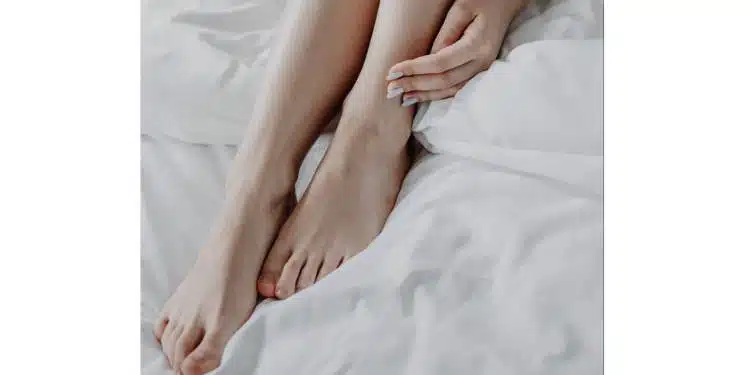by Fayne Frey, M.D. Board Certified Dermatologist
Winter can be beautiful, especially in the Northeast. Think about the white covered mountains, translucent icicles sparkling in the trees, and snow angels embedded in lawns next to adorable snowmen. Even Texas had a lovely little snowfall this year that many enjoyed. Unfortunately, with the beauty of the season comes dry winter air and some really annoying skin issues. So, while you may enjoy the winter, know that it’s not great for your skin.
Nobody Likes Dry Cracked Heels
Recently, a woman in my office told me her pants scratched against the back of her heels when she undressed at night. She complained her heels were so dry they caught on her socks both when she put them on and took them off. When she looked more closely, she noticed the small cracks in her skin.
I explained that dry winter skin is a common problem. In fact, over 20% of American adults over age 21 experience dry cracked heels, especially during the colder months. More women than men suffer with cracked heels, also known as heel fissures. Provided the cracks are small and superficial, this issue is often nothing more than a cosmetic nuisance. However, deep “heel fissures” can be quite painful, and in rare cases, lead to infection.
Why Does the Skin on Your Heels Crack?
A number of possible causes exist for cracked heels and the accompanying dry callused skin around the rim of your heels. Dry winter air commonly causes this condition, however, there are additional factors to consider. Here are some common causes of cracked heels.
Dry winter air
Dry winter air causes skin dryness and prevents the normal layers of skin from shedding.
Prolonged standing
Standing for long periods, especially on hard floors.
Overweight
Obesity increases the pressure exerted on the fat pad in the heel.
Medical issues
Certain medical conditions like diabetic neuropathy, psoriasis, eczema, and fungal infections can cause additional problems.

Treatment for Cracked Heels
As my patient fortunately had no underlying conditions, I provided her with the following recommendations:
Moisturize after showering and reapply later in the day.
Use therapeutic emollients that contain humectants, which are water absorbing compounds like urea or lactic acid.
Exfoliate
Exfoliate as needed with an alpha-hydroxy acid cream to help smooth the skin on the heels.
Apply petrolatum at bedtime.
Occlusive-based moisturizers, like petrolatum, applied at bedtime may soften the calluses and help repair skin dryness and heel cracks. (You might want to wear thin cotton socks to avoid getting the petrolatum on your sheets)
Use a pumice stone.
A pumice stone used after showering, but before moisturizing, gently helps remove dry skin and calluses.
Cover deep fissures with antibacterial ointment.
Antibacterial ointment helps prevent infection if deep fissures develop.
Return to your doctor.
If pain, redness, bleeding, or swelling develops, you need to consult a physician.
The result? My patient did quite well. She purchased an over-the-counter lactic acid and urea-containing moisturizer at a local pharmacy, applying it to her feet every morning and afternoon. She could easily do so while working from home, compliments of Covid-19. In addition, she smothered her heels with petrolatum and wore thin cotton socks at bedtime. Within several days she noticed an improvement. After two weeks, her heels were “back to normal.”
Give Your Feet Some Love to Avoid Dry Cracked Heels
As is the case for many medical conditions, prevention is the best treatment for dry cracked heels! In other words, don’t forget to give your feet a little love. Moisturize your feet regularly during the autumn months, before the very dry low humidity winter air arrives. As recommended above, use a moisturizer with humectants to hydrate the skin on your heels twice a day.
Enjoy the winter and take care of your feet!
About the Author: Dr. Fayne Frey
 Fayne Frey, M.D., is a board-certified clinical and surgical dermatologist practicing in West Nyack, New York, where she specializes in the diagnosis and treatment of skin cancer. She is a nationally recognized expert in the effectiveness and formulation of over-the-counter skincare products, and, as a speaker, has captivated audiences with her wry observations regarding the skincare industry. She has consulted for numerous media outlets, including NBC, USA Today, and, the Huffington Post, and has shared her expertise on both cable and major TV outlets. Dr. Frey is the Founder of FryFace.com, an educational skincare information and product selection service website that clarifies and simplifies the overwhelming choice of effective, safe, and affordable products encountered in the skincare aisles. Dr. Frey is a fellow of both the American Academy of Dermatology and the American Society for Dermatologic Surgery.
Fayne Frey, M.D., is a board-certified clinical and surgical dermatologist practicing in West Nyack, New York, where she specializes in the diagnosis and treatment of skin cancer. She is a nationally recognized expert in the effectiveness and formulation of over-the-counter skincare products, and, as a speaker, has captivated audiences with her wry observations regarding the skincare industry. She has consulted for numerous media outlets, including NBC, USA Today, and, the Huffington Post, and has shared her expertise on both cable and major TV outlets. Dr. Frey is the Founder of FryFace.com, an educational skincare information and product selection service website that clarifies and simplifies the overwhelming choice of effective, safe, and affordable products encountered in the skincare aisles. Dr. Frey is a fellow of both the American Academy of Dermatology and the American Society for Dermatologic Surgery.
Home Remedies for Dry Cracked Heels from Our Readers
FAQs About Dry Cracked Heels
Here are some commonly asked questions about dry cracked heels.
Why do dry cracked heels become painful?
Dry cracked heels can become painful when the skin becomes excessively dry and loses its elasticity. Cracks may deepen, leading to fissures that can be sensitive and painful, especially when pressure is applied.
What are the common symptoms of painful dry cracked heels?
Symptoms may include pain, tenderness, redness, and in severe cases, bleeding. Walking or standing for prolonged periods can exacerbate the discomfort.
Can painful dry cracked heels lead to complications?
Yes, if left untreated, painful dry cracked heels can lead to complications such as infections. Bacteria can enter the open cracks, causing infections that may require medical attention.
Are products with urea or lactic acid effective for treating dry cracked heels?
Yes, products containing urea or lactic acid are often effective for treating dry cracked heels. Urea helps to hydrate and retain moisture, while lactic acid exfoliates and smoothes the skin. Together, they contribute to the overall improvement of the skin’s condition. While urea and lactic acid are generally well-tolerated, individuals with sensitive skin may experience irritation. It’s recommended to perform a patch test before applying these products to larger areas. If irritation occurs, discontinue use and consult a dermatologist.
What is urea, and how does it benefit dry cracked heels?
Urea is a natural compound found in the skin that helps retain moisture. In skincare products, synthetic urea is often used as a humectant, drawing and retaining water in the skin. When applied to dry cracked heels, urea helps to hydrate and soften the skin, promoting healing and preventing further cracking. Look for moisturizers that contain urea or lactic acid.
How does lactic acid benefit dry cracked heels?
Lactic acid is an alpha hydroxy acid (AHA) that acts as an exfoliant and humectant. It helps to remove dead skin cells, promoting gentle exfoliation and smoothing of the skin. In the context of dry cracked heels, lactic acid aids in the removal of rough, dry skin, making the heels softer and more supple. Dermatologists recommend you look for moisturizers that contain lactic acid.
How can I alleviate pain from dry cracked heels?
To alleviate pain, moisturize the heels regularly, use over-the-counter creams, wear comfortable shoes, avoid standing for extended periods, and consider using heel cushions or silicone inserts for added support.
Can I prevent painful dry cracked heels?
Yes, preventive measures include regular moisturizing, proper foot care, wearing comfortable shoes, avoiding prolonged standing, and addressing any underlying health conditions. Early intervention can help prevent the progression to pain and complications.
If you are experiencing persistent pain from dry cracked heels, it’s advisable to consult with a healthcare professional for a personalized assessment and appropriate treatment.
This article is not intended as medical advice. Please visit your doctor with your concerns and questions.










